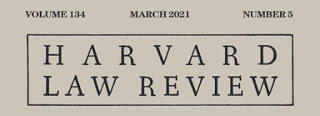In my role as trademark thought follower, I recommend this recent note in the Harvard Law Review, by Grace McLaughlin, entitled "Fanciful Failures: Keeping Nonsense Marks off the Trademark Register," 134 Harv. Law. Rev. 1804 (March 2021). [on-line version here; pdf here]. Ms. McLaughlin discusses the proliferation of registrations for "nonsense" trademarks - marks that consist of an apparently random string of letters unpronounceable in English and with no meaning in another language - often originating in China due to economic incentives offered by the Chinese government, or spawned by a desire to take advantage of Amazon's Brand Registry. She suggests that "by extending failure to function to encompass marks that do not work because they are linguistically incoherent and unmemorable, courts and the USPTO can keep these marks off the Register and prevent them from further muddying the trademark system."
Part I of this Note explains why nonsense marks do not fit within the established purposes of trademark law and why, nevertheless, existing barriers to registration do not filter them out. Part II then explores the problems with having these marks on the Register, outlining the harms to other brand owners, trademark examiners, and the system of meaning established by trademark law. Part III provides an overview of failure to function doctrine, while Part IV advocates for an extension of this doctrine, so that it captures marks that do not function because they have no staying power in consumers' minds. By focusing on whether these marks work as trademarks are supposed to, those applying failure to function can offer a legal basis for the common sense conclusion that the only mark that matters to consumers in this context is Amazon's.
Read comments and post your comment here.
Originally Published by March 12, 2021
The content of this article is intended to provide a general guide to the subject matter. Specialist advice should be sought about your specific circumstances.


